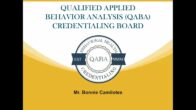So for today’s talk, I will present to you the Qualified Applied Behavior Analysis Credentialing Board. I entered QABA in April 2022, so I will be two years old next month. So yes, credentialed.
Okay, so QABA. So that’s it. Now the Qualified Applied Behavior Analysis is an organization established in 2012 to meet para-professional credentialing needs identified by behavior analysts, ABA providers, insurance providers, government departments and consumers of behavior analysis and behavior health services. So QABA was created to fill a specific need in the professional community. Now QABA is all about making sure that those who work closely with behavior analysts like assistants or other support staff have the proper credentials.
So essentially, QABA makes sure that the people helping out in this important field meet certain standards, ensuring quality and reliability for everyone involved. So QABA offers a three-tier model. So that’s what QABA offers credentials. So first, we have the applied behavior analyst technician. So, they work directly with clients. So, they implement daily lessons and behavior plans created by more experienced professionals under the guidance of licensed professionals such as QASPS, which is the second one, Qualified Autism Services Practitioner Supervisor, QBAs, which is the third one, qualified behavior analyst or licensed psychologist specializing in ABA. And the second credential that we have is the qualified autism services practitioner supervisor. So this one is the supervisory level credential.
So the QASPS credential is a certification per professional, working with autism using applied behavior analysis. So the purpose of this is to ensure that professionals can safely and effectively support individuals with autism, guaranteeing high quality care. Yes, that’s the second credential. And then the third one is we have the qualified behavior analyst. This credential is the third tier, which is the mastery level of the credential.
So the QBA or the Qualified Behavior Analyst indicates advanced expertise in applied behavior analysis, combining mastery level education, supervised practical experience, and ethical professionalism. And ethical, I said unethical, right? And ethical professionalism. So that’s what we’re going to do.
Credentials. Okay, so let’s proceed to the requirements. So the ABAT, the applied behavior analysis technician must be at least 18 years old and at least after high school. They can go to one of our pre-approved coursework providers to complete the 40-hour training. So, the 40-hour training is provided by our pre-approved coursework providers. If you want to know more about the approved providers, I can give you later the website where you can see the list of the approved providers.
So training must be completed within five years unless otherwise specified. So for this one, say for example, you’ve completed the training of ABAT and then you didn’t pass the exam but you already completed it within a five-year time frame. After five years, that certificate of completion will no longer be valid.
So you need to retrain from the pre-approved coursework provider. And then 15 hours of supervised fieldwork, recommendation from the supervisor, criminal background check, that’s very important. And right now, that’s also one of the projects that the QABA board is doing to make sure that there are no criminal cases of the therapists. And then, successful passing of exam proctored by examity, agreed to the QABA code of ethics, all eligibility criteria placement on our public registry renewed every two years.
So once you pass the exam and once the QABA reviews the video and you know, the admin already marked you as passed, then automatically you will be placed in our registry. And these are the competencies covered in the 40 hours of training of ABAT. So I’m not going to go into details about that one. So you may reach out again to our coursework provider since they are the ones who provide the topics already there, but they will discuss it with you.
So we have from autism to data collection analysis. So our second credential, and these are the requirements. So at least 18 years old possess a bachelor’s degree or higher education from a credited university. So once you have your undergraduate pool and you wanted to pursue the second certification, the qualified autism practitioner supervisor, you will need to complete the 188 hours of approved coursework assessment.
So again, this one, you need to coordinate with our pre-approved coursework providers. They’re the ones who’s providing the 188 hours of approved assessment-based ABA coursework. And then 1,000 hours of supervised fieldwork, recommendation from your supervisor, criminal background check, and I think the rest is the same as what you’ve seen earlier is the ABAT.
Okay, so these are the competencies covered, so 188 hours of QASPS. So I think what you saw earlier in ABAT, it only has like 7 competencies now. For QASPS, they’ve added the assessment and then the training and supervision. So you need to complete everything, 188 hours and then 1,000 hours of fieldwork for you to be eligible to take the exam.
And then there, the mastery level, the QBA. So yes, of course, at least 18 years of age possess a minimum of mastery degree or higher degree from an accredited university. You must have completed 270 hours of approved coursework or 18 semester credit units, including 20 hours of supervision coursework.
So for this one, so the mastery level requires the candidate to at least complete 270 hours of approved coursework. And then 1,500 or 1,500 hours of supervised fieldwork with minimum of 900 hours in the role of a supervisor or program development. So we have the recommendation from one evaluator or supervisor, criminal background check, you need to pass the exam, agreed to the code of ethics. And so let’s go to the, okay, these are the competencies.
For this one, as I’ve mentioned earlier, 270 hours, you need to complete for the QBA competencies. So same as QASPS, but QASPS, you can, the hours, the first which is the 188 hours and this one is 270 hours. This is the mastery level. Okay, there it is, the exciting part. Okay, so the original price, like… So for each credential, for the ABAT, you are going to pay 125 but now QABA actually they offer cost adjustments for candidates from developing countries. So now I’ve added $60, 125, and 225. Those are the discounts that are already being made. For you to get a discount, you just need to enroll. Like say for example, you’ve already completed your training in ABAT, you’ve also completed your supervision and you’re ready to take the exam.
So the next thing that you need to do is to go to our website, that’s www.qababoard.com, and then enroll, whatever your credential you enrolled in, say for example, in ABAT, once you enrolled, automatically it will ask you, like in your user profile, if you’re from the Philippines, automatically it will ask you if you want to apply for a discount.
So there you can upload your utility bill and then your ID. And then once approved by the board, automatically the fee is discounted. So $60, $125, and $225. So we have a retake fee if unfortunately you’re not going to pass the exam. Of course, it’s discounted and the prices that you can see there, the fees I mean, it’s already discounted. So, 50, 110, and then 200 dollars for the QBA. The renewal fee as well. There are discounts on QAS, PSS, and QBA but the fees that you’re seeing there are not yet discounted. I need to ask the board how much are they going to give discounts for QAS, PSS, and QBA for the renewal.
But anyway, let’s worry about that after two years, right? If you already have a chance. So the QABA established a process to predetermine the qualifications of existing coursework providers through colleges, universities, service providers, online training companies. So if you want to become a coursework provider, there are actually guidelines.
And I actually don’t want to go into details about that because before, if you are going to pass the QASPS and the QBA exam, you can then apply to become a coursework provider. Now they changed it because they think it’s easy to apply as a coursework provider. So they changed it. You need to be at least two years as a QBA or QASPS and by then you can apply as a coursework provider.
If you just passed the exam and you really want to become a coursework provider, you can ask for another QBA or BCBA to sign with you. Meaning, they will still oversee you. And then, examination. The good thing about QABA is you do not go to a testing center. So you can only do it at home as long as you have a strong internet connection. And then alone in your room. And then proctored by examity. So you need to have your computer, your camera open for the whole duration of the exam. And the first thing that the proctor will ask you is to scan your surroundings. Making sure that there are no other people.
There are no notes on your desk. So, 360 degrees and then even your desk, all of them. Proctor will scan them. Even your eyes will be like this. You can’t. Proctor will call you out. So, that’s the examination. The registry. So, as I’ve mentioned earlier, once you pass the exam and then you already have the certification.
The registry is actually accessible to the public. Of course, it’s called public registry. So if someone asks if you’re really legit about ABAT or QA, SPS or QBA, then you can send them the website. And then, okay, you can find me here. I’m in the registry. So this is our accreditation.
So QABA is internationally accredited by ANSI. The Americans call it ANSI. That’s their accent. And our policies and procedures have been fully vetted and measured against the highest industry standards. And that makes the QABA as the only internationally accredited entity for ABA. Which I’m very proud of.
So, our impact is with children, families, organizations, practitioners, insurance companies. So, for children, high quality services, increase in services, offered positive outcomes, access to care. For families, less stress, reduce physical injuries of family members. And yes, the QBA QASP and ABOT credential programs have addressed the need to recognize those individuals who have had specific education and training in autism spectrum disorder and applied behavior analysis and are providing behavior health services under the supervision of a licensed or certified professionals. So that’s about it.

























